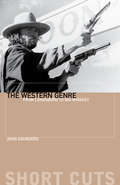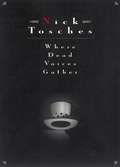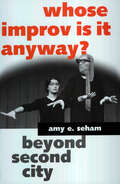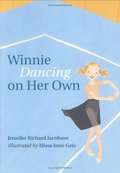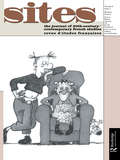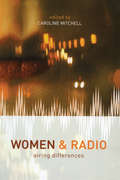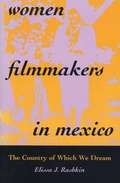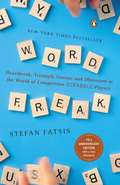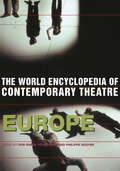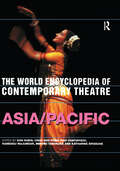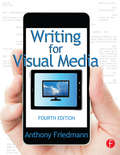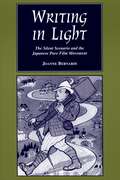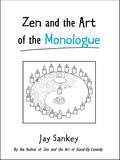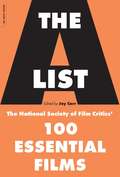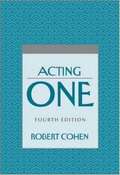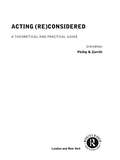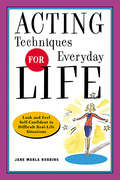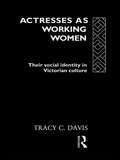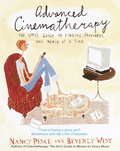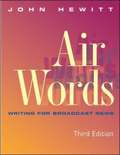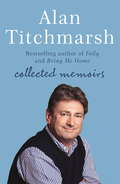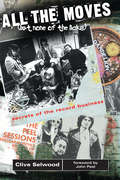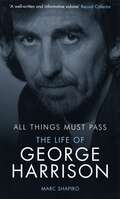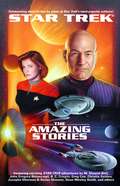- Table View
- List View
The Western Genre: From Lordsburg to Big Whiskey (Short Cuts)
by John SaundersThe Western Genre: From Lordsburg to Big Whiskey offers close readings of the definitive American film movement as represented by such leading exponents as John Ford, Howard Hawks, and Sam Peckinpah. In his consideration of such iconic motifs as the Outlaw Hero and the Lone Rider, John Saunders traces the development of perennial aspects of the genre, its continuity and, importantly, its change. Representations of morality and masculinity are also foregrounded in consideration of the genre's major stars John Wayne and Clint Eastwood, and such films as Shane, Rio Bravo, The Wild Bunch, and Unforgiven.
Where Dead Voices Gather
by Nick ToschesNick Tosches - author of HELLFIRE and DINO - spent twenty years searching for facts about Emmett Miller, a forgotten figure from the early days of jazz. A yodelling blackface performer wit an unforgettable voice, Miller's songs prefigured jaxx, country, blues and much of the popular music of the twentieth century. Starting with a handful of 78 records and ending in a graveyard in Macon, Georgia, WHERE DEAD VOICES GATHER is part biography, part meditation on the meaning and power of music.
Whose Improv Is It Anyway?: Beyond Second City (Studies in Popular Culture Series)
by Amy E. SehamOn both sides of the stage improv-comedy's popularity has increased exponentially throughout the 1980s and '90s and into the new millennium. Presto! An original song is created out of thin air. With nothing but a suggestion from the audience, daring young improvisers working without a net or a script create hilarious characters, sketches, and songs. Thrilled by the danger, the immediacy, and the virtuosity of improv-comedy, spectators laugh and cheer. American improv-comedy burst onto the scene in the 1950s with Chicago's the Compass Players (best known for the brilliant comedy duo Mike Nichols and Elaine May) and the Second City, which launched the careers of many popular comedians, including Gilda Radner, John Belushi, and Mike Myers. Chicago continues to be a mecca for young performers who travel from faraway places to study improv. At the same time, the techniques of Chicago improv have infiltrated classrooms, workshops, rehearsals, and comedy clubs across North and South America, Europe, Australia, and Japan. Improv's influence is increasingly evident in contemporary films and in interactive entertainment on the internet. Drawing on the experiences of working improvisers, Whose Improv Is It Anyway? provides a never-before-published account of developments beyond Second City's mainstream approach to the genre. This fascinating history chronicles the origins of "the Harold," a sophisticated new "long-form" style of improv developed in the '80s at ImprovOlympic and details the importance and pitfalls of ComedySports. Here also is a backstage glimpse at the Annoyance Theatre, best known on the national scene for its production of The Real Live Brady Bunch. Readers will get the scoop on the recent work of players who, feeling excluded by early improv's "white guys in ties," created such independent groups as the Free Associates and the African American troupe Oui Be Negroes. There is far more to the art of improv than may be suggested by the sketches on Saturday Night Live or the games on Whose Line Is It Anyway? This history, an insider's look at the evolution of improv-comedy in Chicago, reveals the struggles, the laughter, and the ideals of mutual support, freedom, and openness that have inspired many performers. It explores the power games, the gender inequities, and the racial tensions that can emerge in improvised performance, and it shares the techniques and strategies veteran players use to combat these problems. Improv art is revealed to be an art of compromise, a fragile negotiation between the poles of process and product. The result, as shown here, can be exciting, shimmering, magical, and not exclusively the property of any troupe or actor.
Winnie (Dancing) on Her Own
by Jennifer Richard JacobsonFor the first time since they were five, the girls didn't know how to be with one another. It was as if Winnie had said "I don't want to be in the club anymore." Threesomes are hard, everyone says, but since kindergarten, Vanessa, Winnie, Zoe--the End-of-the-Alphabet-Club--have done everything together: sleepovers, trips to the library, games at recess. Yet now, as the world of ballet enters their lives, Winnie fears she will lose her two best friends. Simply told, this early chapter book explores the mysteries and joys of friendship.
Women
by Revue D’études FrançaisesPublished in 2001, Women is a valuable contribution to the field of Performance.
Women and Radio: Airing Differences
by Caroline MitchellCombining classic work on radio with innovative research, journalism and biography, Women and Radio offers a variety of approaches to understanding the position of women as producers, presenters and consumers as well as offering guidelines, advice and helpful information for women wanting to work in radio.Women and Radio examines the relationship between radio audiences, technologies and programming and reveals and explains the inequalities experienced by women working in the industry.
Women Filmmakers in Mexico: The Country of Which We Dream
by Elissa J. RashkinWomen filmmakers in Mexico were rare until the 1980s and 1990s, when women began to direct feature films in unprecedented numbers. Their films have won acclaim at home and abroad, and the filmmakers have become key figures in contemporary Mexican cinema. In this book, Elissa Rashkin documents how and why women filmmakers have achieved these successes, as she explores how the women's movement, film studies programs, governmental film policy, and the transformation of the intellectual sector since the 1960s have all affected women's filmmaking in Mexico. <P><P> After a historical overview of Mexican women's filmmaking from the 1930s onward, Rashkin focuses on the work of five contemporary directors--Marisa Sistach, Busi Cortés, Guita Schyfter, María Novaro, and Dana Rotberg. Portraying the filmmakers as intellectuals participating in the public life of the nation, Rashkin examines how these directors have addressed questions of national identity through their films, replacing the patriarchal images and stereotypes of the classic Mexican cinema with feminist visions of a democratic and tolerant society.
Word Freak: Heartbreak, Triumph, Genius, and Obsession in the World of Competitive Scrabble Players
by Stefan FatsisStefan Fatsis first became intrigued with Scrabble as he watched serious players in New York's Washington Square. As he delved deeper, he found that professional players approached the game with obsessive zeal, memorizing word lists, comparing ratings, and calculating mathematical odds of drawing a winning rack of tiles. Fatsis himself became fascinated with the game and honed his own skills until he was able to enter tournaments with the pros. In this book Fatsis introduces many of the eccentrics who make Scrabble their life, and traces the history of the game from its origins in the 1930s.
World Encyclopedia of Contemporary Theatre: Volume 1: Europe (World Encyclopedia Of Contemporary Theatre Ser.)
by Don Rubin Péter Nagy Philippe RouyerThis new paperback edition of the The World Encyclopedia of Contemporary Theatre: Europe covers theatre since World War II in forty-seven European nations, including the nations which re-emerged following the break-up of the former USSR, Czechoslovakia and Yugoslavia. Each national article is divided into twelve sections - History, Structure of the National Theatre Community, Artistic profile, Music Theatre, Theatre for Young Audiences, Puppet Theatre, Design, Theatre, Space and Architecture, Training, Criticism, Scholarship and Publishing and Further Reading - allowing the reader to use the book as a source for both area and subject studies.A new preface and further reading sections by the Series Editor brings the Encyclopedia bang up-to-date making it invaluable to anyone interested in European theatre, as well as students and scholars of performance studies, history, anthropology and cultural studies.
The World Encyclopedia of Contemporary Theatre: Volume 5: Asia/Pacific
by Don Rubin Chua Soo Pong Ravi Chaturvedi Ramendu Majumdar Minoru Tanokura Katherine BrisbaneThis new paperback edition provides a unique examination of theatre in Asia and the Pacific and is written by leading experts from within the countries covered. Its far-reaching scope and broad interpretation of theatre (to include all types of performance) set it apart from any other similar publication. Entries on 33 Asian countries are featured in this volume, preceded by introductory essays on Asian Theatre, Theatre in the Pacific, History and Culture, Cosmology, Music, Dance, Theatre for Young Audiences, Mask Theatre and Puppetry.The volume contains approximately 300,000 words and includes national essays of up to 25,000 words each. The countries include:Afghanistan * Australia * Bangladesh * Bhutan * Brunei * Cambodia * India * Indonesia * Iran * Japan * Kazakhstan *Kirghizia * Laos * Malaysia * Myanmar * Mongolia * Nepal *New Zealand * Pakistan * Papua New Guinea * PhilippinesNew Zealand * Pakistan * Papua New Guinea * Philippines *Singapore * South Korea * South Pacific * Sri Lanka * Tadjikistan * Thailand * Turkmenistan * Vietnam
Writing for Visual Media
by Anthony FriedmannThis updated edition of Writing for Visual Media will enable you to understand the nature of visual writing that lies behind the content of all visual media. This unique kind of writing must communicate to audiences through content producers, since audiences don't read the script. Most media content provides a solution to a communication problem, which the writer must learn to analyze and solve before writing the script. The Fourth Edition strengthens the method for creating content and writing in the correct language and established format for each visual medium, including commercial communication such as ads and PSAs, corporate communications, and training. An extended investigation into dramatic theory and how entertainment narrative works is illustrated by examples and detailed analysis of scenes, scripts and storylines, saving you designed to save writers from typical pitfalls and releasing your creative powers of invention. Writing for Visual Media will help you to develop an improved foundation for understanding interactive media and writing for non-linear content, while gaining the tools to effectively connect with your audience like a professional. Purchase of this book includes access to the companion website, which provides: Sample scripts and video clips of those produced scripts An interactive glossary of camera shots, movements, and transitions Storyboards, scripts, screenplays, and links to industry resource Instructor materials such as PowerPoint lecture slides, a sample syllabus, and a test bank. Visit the site at www.routledgetextbooks.com/textbooks/9780415815857
Writing in Light: The Silent Scenario and the Japanese Pure Film Movement
by Joanne BernardiWhile most people associate Japanese film with modern directors like Akira Kurosawa, Japan's cinema has a rich tradition going back to the silent era. Japan's "pure film movement" of the 1910s is widely held to mark the birth of film theory as we know it and is a touchstone for historians of early cinema. Yet this work has been difficult to access because so few prints have been preserved. Joanne Bernardi offers the first book-length study of this important era, recovering a body of lost film and establishing its significance in the development of Japanese cinema. Building on a wealth of original-language sources--much of it translated here for the first time--she examines how the movement challenged the industry's dependence on pre-existing stage repertories, preference for lecturers of intertitles, and the use of female impersonators. Bernardi provides in-depth analysis of key scripts--The Glory of Life, A Father's Tears, Amateur Club, and The Lust of the White Serpent--and includes translations in an appendix. These films offer case studies for understanding the craft of screenwriting during the silent era and shed light on such issues as genre, authorship and control, and gender representation. Writing in Light helps fill important gaps in the history of Japanese silent cinema. By identifying points at which "pure film" discourse merges with changing international trends and attitudes toward film, it offers an important resource for film, literary, and cultural historians.
Zen and the Art of the Monologue
by Jay SankeyJay Sankey--stand-up comic, magician, and cartoonist--is back with another book for performers. Building on the success of his Zen and the Art of Stand-up Comedy, Jay is moving further into the uncharted wilds of solo performance.
The A List: The National Society Of Film Critics' 100 Essential Films
by Jay CarrThe 100 essential films of all time (you might be surprised what they are) and why they matter (you might be surprised about that, too).
Acting One (4th edition)
by Robert CohenUsed to teach beginning acting on more campuses than any other text, Acting One contains twenty-eight lessons based on experiential exercises. The text covers basic skills such as talking, listening, tactical interplay, physicalizing, building scenes, and making good choices.
Acting (Re)Considered (Re)Considered: A Theoretical and Practical Guide
by Phillip B. ZarrilliActing (Re)Considered is an exceptionally wide-ranging collection of theories on acting, ideas about body and training, and statements about the actor in performance. This second edition includes five new essays and has been fully revised and updated, with discussions by or about major figures who have shaped theories and practices of acting and performance from the late nineteenth century to the present.The essays - by directors, historians, actor trainers and actors - bridge the gap between theories and practices of acting, and between East and West. No other book provides such a wealth of primary and secondary sources, bibliographic material, and diversity of approaches. It includes discussions of such key topics as:* how we think and talk about acting* acting and emotion* the actor's psychophysical process* the body and training* the actor in performance* non-Western and cross-cultural paradigms of the body, training and acting.Acting (Re)Considered is vital reading for all those interested in performance.
Acting Techniques for Everyday Life: Look and Feel Self-Confident in Difficult, Real-Life Situations
by Jane Marla RobbinsMost people can name at least one situation?a business presentation, a job interview, a cocktail party, or a blind date?in which they felt uncomfortable, nervous, or simply self-conscious. Jane Marla Robbins, a successful stage and film actress and teacher for almost forty years, found that she could use the same acting techniques she employed to look and feel confident on stage and screen to make herself feel more comfortable in ?real-lifeOCO situations. In clear and accessible language, Robbins describes acting techniques that actors having been using for centuries and explains?using real-life examples and easy-to-follow exercises?how each can be used by ordinary people to make difficult everyday situations easier to handle. Acting Techniques for Everyday Life will teach readers how to create a sense of well-being and self-confidence at will, giving them the tools they need to be as confident, strong, witty, authentic, relaxed, and happy as they want to be in any given situation. "
Actresses as Working Women: Their Social Identity in Victorian Culture (Gender in Performance)
by Tracy C. DavisUsing historical evidence as well as personal accounts, Tracy C. Davis examines the reality of conditions for `ordinary' actresses, their working environments, employment patterns and the reasons why acting continued to be such a popular, though insecure, profession. Firmly grounded in Marxist and feminist theory she looks at representations of women on stage, and the meanings associated with and generated by them.
Advanced Cinematherapy: The Girl's Guide to Finding Happiness One Movie at a Time
by Nancy Peske Beverly WestMOVIES ARE MORE THAN ENTERTAINMENT–THEY’RE A BUBBLE BATH FOR THE SOUL. On the verge of yet another major life change? Recovering from a rough day at the office? Or trying to figure out what makes him tick? Take heart–no matter what your issue, the help you need is no farther away than your VCR. From the dynamic duo who brought you the bestsellingCinematherapycomesAdvanced Cinematherapy, a video guide that prescribes the perfect movie to cure whatever ails you. Whether you’re in the midst of a midlife crisis and need to join the parade and march to your own drummer (Hello, Dolly!), or vacillating between gullible and hyperparanoid and need to listen to your instincts (Sudden Fear), inAdvanced Cinematherapyyou’ll find movies that will help you laugh at your troubles or confront your issues, and inspire you to grow. Struggling with growing pains? Watch a Coming of Age and Coming Out movie likeBut I’m a Cheerleaderand celebrate your true colors. Ready to cry a river? Immerse yourself in a Cathartic Weeper likePenny Serenadeand let it all out. Face-to-face with a nuclear family meltdown? Pop in a Dysfunctional Family movie likeAddams Family Valuesand laugh at your own kooky clan. Here are dozens of new reviews of classic and contemporary movies that confront women’s issues and nurture women’s souls. Feed your wildest fantasies, claim your power, and overcome your losses, all by taking charge of your own remote control! AND DON’T MISS: Bev’s Culinarytherapy: Foods for Every Mood, Nancy’s Momentous Minutiae, Diva Diamonds, Hoopskirt Dreams, the Handy Hunk Chart, and much, much more. . . . From the Trade Paperback edition.
Air Words: Writing for Broadcast News
by John HewittAn introductory text for broadcast newswriting, with numerous exercises and examples illustrating broadcast news style. Defines and explains standard industry formats, rules, and procedures, and covers fact checking, ethics, script formats, shifting from print to broadcast, writing leads, interviews, aspects of TV writing, and copyediting and producing. Includes chapter glossaries. This second edition discusses technology advances such as wire capture and producing from CRTs. Lacks a bibliography. Annotation c. by Book News, Inc., Portland, Or.
Alan Titchmarsh: Trowel and Error, Nobbut a Lad, Knave of Spades
by Alan TitchmarshIn these three bestselling memoirs, Alan tells his own story from Ilkley Moor to Pebble Mill and to the final realising of his dream of becoming TV's favourite gardener. Along the way, the cast of characters includes everyone from Auntie Ethel to Nelson Mandela and the Queen.
Alan Titchmarsh: Trowel and Error, Nobbut a Lad, Knave of Spades
by Alan TitchmarshIn these three bestselling memoirs, Alan tells his own story from Ilkley Moor to Pebble Mill and to the final realising of his dream of becoming TV's favourite gardener. Along the way, the cast of characters includes everyone from Auntie Ethel to Nelson Mandela and the Queen.
All the Moves (But None of the Licks): Secrets of the Record Business
by Clive SelwoodClive Selwood is the man who invented "chart hyping," the man who started the first "hippie" record label, and who pioneered the concept of radio "session" recordings with one of the most successful independent record labels ever. Replacing Des O'Connor as a Butlin Redcoat, falling foul of London gangsters, taking a major record company to the top of the league, getting fired and taking sweet revenge by making its main rival the No.1 singles company--Clive Selwood has had his fingerprints all over the secret machinations of both the UK and international music industries for over four decades. A director of such international record companies as Elektra, UK Records, CBS, and Pye, and creator, with John Peel, of the Dandelion independent label and Strange Fruit Records, Clive Selwood worked with such legendary names as Jim Morrison, Paul Simon, Bruce Springsteen, Barry White, Rod Stewart, Abba, Elton John, and hundreds more. Illustrated with photographs from the author's private collection, this memoir covers every facet of the music business--lawyers, chart fixing, marketing, record production, music festivals, record executives and personalities, artist management, sex, bribery, and the creation of both successful and unsuccessful record companies. Having helped to shape and guide the careers of some of the world's leading recording artists, Clive Selwood chooses to dedicate this fascinating memoir to the millions of "air guitarists" with all the classic moves of their heroes--from Slowhand to Slipknot--but none of their licks, and the countless souls trapped in mundane jobs who dream of the danger and the excitement that the music business would appear to offer.
All Things Must Pass: The Life of George Harrison
by Marc ShapiroGeorge Harrison was always known as the 'quiet Beatle' As part of the biggest band in pop history, he took a back seat to Paul McCartney and John Lennon, but his talent shone through in the composition of classic songs such as 'Something' and 'Here Comes The Sun'. In his solo career he occasionally threatened to eclipse both John and Paul on the world stage, and he joined forces with Bob Dylan, Tom Petty, Roy Orbison and Jeff lynne to create the massively succsessful supergroup the Traveling Wilburys.However, the success of his professional life was often met by turmoil in his private life, and the loss of first wife Patti to best friend Eric Clapton, the traumatic attempt on his life by a knife wielding intruder and his final struggle against cancer meant that George Harrison's life was nothing if not dramatic.Bestselling author Marc Shapiro has exclusively interviewed friends and former colleagues of the enigmatic guitar legend. This revealing biography reaffirms Harrison's importance as an innovative and hugely talented musician and shows that, as a member of the most important band ever, as well as in his multi-faceted career after the Beatles, George Harrison was no ordinary man.
The Amazing Stories (Star Trek)
by John J OrdoverFrom 1998 to 2000, Amazing Stories, the world's oldest science fiction magazine, presented a series of original Star Trek stories written by a number of bestselling authors. Now these little-seen Star Trek adventures are collected here for the first time, together with new tales written especially for Star Trek: Amazing Stories. Among the highlights of this collection: Spock comes to terms with the death of his father in a touching tale from A.C. Cripsin, author of SAREK; Counsellor Troi risks everything to aid the evacuation of a dying planet; Seven of Nine learns a lesson in humanity when the USS Voyager takes on some unusual alien visitors; Beverley Crusher discovers that holographic doctors take some getting used to, especially during a medical emergency; and Captain Proton, Defender of the Earth, faces the awesome menace of Space Vortex of Doom.
